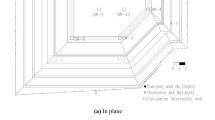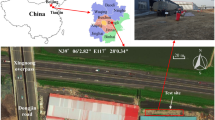Abstract
A whirlpool foundation pit is a small-diameter, deep circular pit. Because of its depth and small diameter, a large drawdown is required, and a limited number of wells can be installed inside the pit. During excavation, partially penetrating wells inside and outside the foundation pit have to be installed to lower the water level when the aquifer is too thick. However, partially penetrating wells near partially penetrating curtains cannot be treated by analytical methods. Therefore, it is necessary to use numerical methods to predict dewatering during excavation. Field experiments were performed on whirlpool foundation pit 1880 of Baosteel Group, Shanghai, China, to obtain pumping rates and drawdown, pumping with a single well and two wells in the confined aquifer. The results indicate that the drawdown inside the pit induced by pumping wells outside the foundation pit was small, whereas it was large for pumping wells inside the pit. The pumping wells inside and outside the pit had to be combined to lower the water level. A three-dimensional numerical model was developed to simulate the dewatering process. The hydraulic conductivities of the confined aquifers were inversed by using the pumping tests. Operation schedules were simulated with the corrected model for different combinations of wells inside and outside the pit. The results suggest that different schedules and operation conditions affect drawdown. The monitored results during dewatering indicate that the simulation and field measurements were in agreement. The results can be applied to similar situations.














Similar content being viewed by others
References
Anderson MP, Woessner WW (1991) Applied groundwater modeling simulation of flow and advective transport. Academic Press, San Diego
Dong XP, Guo QH, Zhou SH (2005) Character and factor analysis of deformation of diaphragm wall in the cylindrical foundation pit. Chin J Undergr Space 2:196–199 (in Chinese)
Dong Q, Ye H, Han XL (2009) Comprehensive construction technology of heating furnace foundation excavation in 1880 mm hot rolled strip of Baosteel Group. Chin J Constr Tech 38:86–88 (in Chinese)
Jiang SM, Kong XL, Ye H et al (2013) Groundwater dewatering optimization in the Shengli no. 1 open-pit coalmine, Inner Mongolia, China. Environ Earth Sci 69:187–196
Liu FQ, Wang JH (2006) The active earth pressure of circular pit subjected to non-uniform surcharge loading. J Shanghai Jiao Tong University 40:2134–2136 (in Chinese)
Luo D (1994) The mechanical analysis of circular underground continuous wall. J Xi’an Metall Eng Coll 40:2134–2136 (in Chinese)
McDanld MG, Harbaugh AW (1988) A modular three-dimensional finite-difference groundwater flow model. Techniques of water-resources investigations 06-A1, USGS 576
Prater EG (1977) Examination of some theories of earth pressure on shaft linings. Can Geotech J 14:91–106
Qiu JT, Zhou J (2004) 3-Dimensional numerical analysis in a very deep circle pit. J Kunming University of Sci Technol 29:96–99 (in Chinese)
Wang SZ, Liu XG (1993) The calculation method of circular underground continuous wall with hull form. Chin J Harb Eng Tech 21:36–43 (in Chinese)
Wang JX, Hu LS, Wu LG, Tang YQ, Zhu YF, Yang P (2009) Hydraulic barrier function of the underground continuous concrete wall in the pit of subway station and its optimization. Environ Geol 57:447–453
Wang JX, Wu YB, Zhang XS, Liu Y, Yang TL, Feng B (2012a) Field experiments and numerical simulations of confined aquifer response to multi-cycle recharge-recovery process through a well. J Hydrol 464–465:328–343
Wang JX, Feng B, Liu Y, Wu LG, Zhu YF, Zhang XS, Tang YQ, Yang P (2012b) Controlling subsidence caused by de-watering in a deep foundation pit. B Eng Geol Environ 71:545–555
Wang JX, Feng B, Guo TP, Wu LG, Lou RX, Zhou Z (2013a) Using partial penetrating wells and curtains to lower the water level of confined aquifer of gravels. Eng Geol 161:16–25
Wang JX, Feng B, Yu HP, Guo TP, Yang GY, Tang JW (2013b) Numerical study of dewatering in a large deep foundation pit. Environ Earth Sci 69:863–872
Yang Y (2008) The Research on design and construction of ultra-deep circular pits in soft soil. Dissertation, Xi’an University of Architect and Construction
Zheng RM, Hu YY (2005) Active earth pressure on circular shaft lining obtained by simplified slip line solution with general tangential stress coefficient. Chin J Geotech Eng 27:110–115
Zhou NY, Zhang Y (2009) The emergency treatment of inrushing in whirlpool pit of steel company of Liao Ning Province. Chin Hi-tech Enterp 19:192–193
Acknowledgments
This work was supported in part by a research grant (No. 41072205) from the National Natural Science Foundation of China and in part by a research grant (No. 201311045-04) from the Special Fund for Land and Resources Scientific Research in the Public Interest of China.
Author information
Authors and Affiliations
Corresponding author
Rights and permissions
About this article
Cite this article
Wang, J., Huang, T., Hu, J. et al. Field experiments and numerical simulations of whirlpool foundation pit dewatering. Environ Earth Sci 71, 3245–3257 (2014). https://doi.org/10.1007/s12665-013-2981-z
Received:
Accepted:
Published:
Issue Date:
DOI: https://doi.org/10.1007/s12665-013-2981-z




